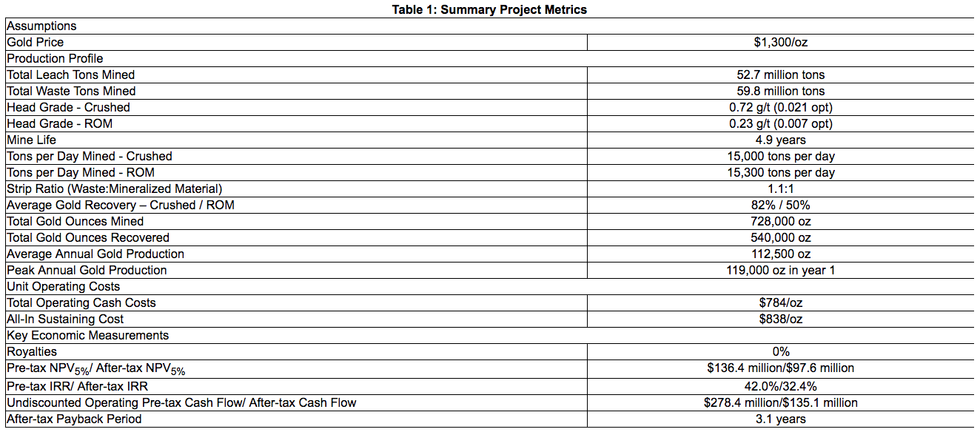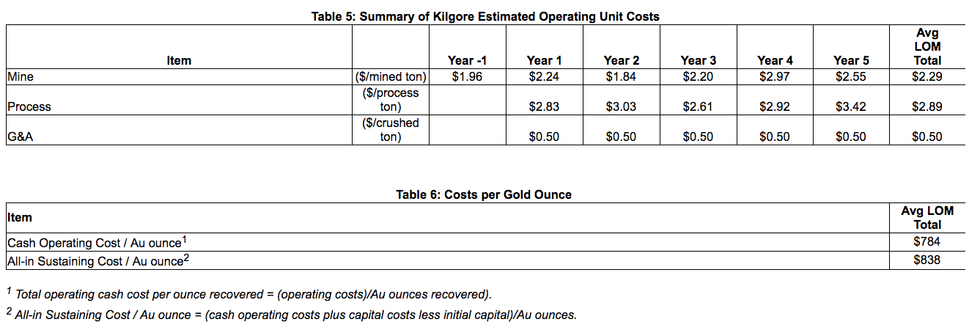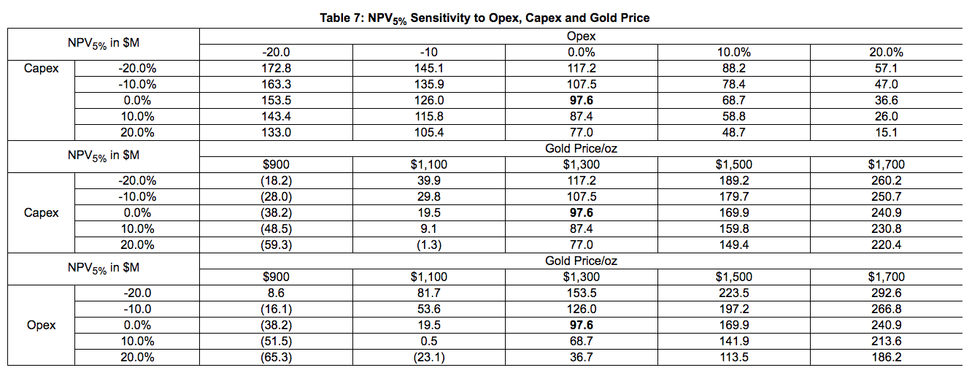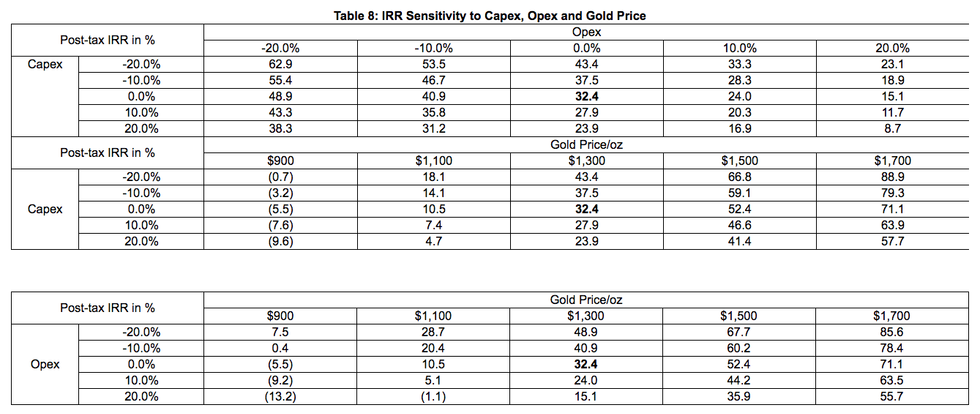Otis Gold Announces Positive Kilgore Preliminary Economic Assessment
Otis Gold Corp. (“Otis” or the “Company”) (TSXV:OOO, OTC:OGLDF) is pleased to announce the completion of its maiden Preliminary Economic Assessment (or “PEA”) at the Kilgore volcanic- and sediment-hosted epithermal gold deposit, Clark County, Idaho.
Otis Gold Corp. (“Otis” or the “Company”) (TSXV:OOO, OTC:OGLDF) is pleased to announce the completion of its maiden Preliminary Economic Assessment (or “PEA”) at the Kilgore volcanic- and sediment-hosted epithermal gold deposit, Clark County, Idaho. The PEA utilizes the resource estimate completed in August, 2018 (see Otis news release dated September 28, 2018), and provides a robust economic scenario upon which to expand the potential scope and scale of the project with ongoing drilling. The PEA supports the potential for a low capital intensity, low operating cost, open-pit, heap-leach operation producing 112,500 ounces of gold per year over a 4.9 year mine life and generating highly attractive economics.
Otis Gold president and CEO, Craig Lindsay, stated, “This PEA is a milestone for both the Kilgore Project and Otis Gold. The work is based on a resource estimate developed from 381 drill holes and 93,000 metres of drilling, with 85% of the resource in the Indicated category. The process design utilizing both crushed and ROM material optimizes the economics of the project, delivers a low strip ratio, produces more ounces and reduces mine life in comparison to an “all crush” processing scenario. We see this project as scalable in terms of both size and throughput through future addition to the resource base via permitted step-out drilling immediately adjacent to the deposit and exploration drilling at well-defined targets throughout the project area and beyond”.
PEA Highlights
- After-tax NPV (5% discount rate) of US$97.6 million and IRR of 32.4 %, with a 3.1-year payback period and LOM net cash flow of US$135.1 million;
- Pre-tax NPV (5 % discount rate) of US$136.4 million and IRR of 42.0%;
- Total amount of gold recovered is estimated at 540,000 ounces;
- Average annual gold production of approximately 112,500 ounces;
- Peak annual gold production of approximately 119,000 ounces in year 1;
- Mine life of 4.9 years with a 1-year preproduction period;
- Average crushed material gold grade of 0.72 g/t and average ROM gold grade of 0.23 g/t;
- Low LOM strip ratio of 1.1:1;
- Royalties – 0%;
- LOM direct operating cash cost1 is estimated at US$784/oz of gold recovered;
- Average LOM all-in sustaining cost (or “AISC2) is estimated at US$838/oz of gold recovered;
- Pre-production initial capital cost estimated at $US81.0 million, using contract mining; and
- LOM sustaining capital costs estimated at US$97.0 million.
1 Cash cost includes mining cost, mine-level general and administrative, leaching, and refining cost.
2 All-in sustaining cost (AISC) includes cash cost per ounce, sustaining capital and closure costs.
The economic model assumes a gold price of US$1,300/ounce. All currency figures stated herein are United States dollars unless otherwise noted. The technical report for the PEA, pursuant to National Instrument 43-101, will be filed on SEDAR within 45 days. The PEA was prepared by Global Resource Engineering, Ltd. of Denver, Colorado.
The PEA is preliminary in nature and includes Inferred mineral resources that are too speculative geologically to have economic considerations applied to them that would enable them to be categorized as mineral reserves. There is no certainty that the PEA results will be realized. Mineral resources are not mineral reserves and do not have demonstrated economic viability.
PEA Overview
The Kilgore deposit is interpreted as a low sulfidation epithermal deposit associated with caldera-related volcanic and intrusive activity. The current defined resource area is a zone of mineralization approximately 800 metres long, 600 metres wide, and 325 metres deep from ground surface to the maximum inferred mineral resource depth. Mineralized intercepts generally average 40 metres (130 feet) and range up to 100 metres (330 feet) in thickness in the Mine Ridge core and North Target areas.
The PEA envisions recovery of gold from crushed and run-of-mine mineralized material using a heap leach facility. The pregnant leach solution from the heap leach would be collected in a dedicated pond and either recirculated or processed in the Adsorption-Desorption-Recovery (ADR) plant. The gold in the solution would be collected on activated carbon in a series of carbon-in-column (CIC) vessels. Gold recovery would take place through stripping the activated carbon into an enriched solution that reports to an electrowinning circuit. The gold would then be recovered as a sludge that would ultimately be smelted into high purity doré bars. Important project metrics are presented in the following tables.
The total estimated capital costs for the project, including contingency, are $97.0 million, with initial capital costs of $81.0 million, as shown in Table 2 below.
Mining Method
The PEA study utilizes open-pit mining with mine planning based on economic pit shells generated by mine planning software. Mine production is planned at approximately 30,000 tons per day or 11.1 million tons per year of leach feed (mineralized) material. With an average waste-to-leach-feed-material strip ratio of 1.1 to 1, the average mining rate is approximately 61,500 tons per day of leach feed and waste material. The open-pit mining at Kilgore was designed utilizing contract mining.
Recovery Methods
A conventional heap leach process is best suited for the Kilgore deposit; higher grade material would be crushed prior to being placed on the heap and the rest would be treated directly as run-of-mine (ROM). Mined material with a cut-off grade greater than 0.01 opt (>0.34 g/t) would be crushed to ½ inch to improve gold recovery as indicated by metallurgical testing; grades between 0.004 opt (>0.15 g/t) and 0.01opt (<0.34 g/t) would go straight to the leach pad as ROM material. All material placed on the pad would have lime added prior to pad placement for pH control. The ROM material would be trucked and dumped on the pad and ripped with a dozer after each lift is complete. The crushed material would be conveyed/stacked on the heap leach facility (HLF). The pregnant leach solution from the heap leach would be collected in a dedicated pond and either recirculated or processed in the Adsorption-Desorption-Recovery (ADR) plant. The gold in the solution would be collected on activated carbon in a series of carbon-in-column (CIC) vessels. Gold recovery would take place through stripping the activated carbon into an enriched solution that reports to an electrowinning circuit where the gold would be recovered as a sludge that is ultimately smelted into high purity doré bars.
Operating Costs
The total life of mine operating costs are estimated to be $423.7 million. Average LOM unit costs for mining, processing and G&A are $2.29/mined ton, $2.89/process ton, $0.51/process ton respectively (annual estimates are shown in Table 4 and Table 5).
The Kilgore deposit includes potentially recoverable silver as well as gold. Silver assays were conducted on approximately 3,906 samples, however, they were not incorporated into the block model, and therefore the Mineral Resource Estimate of August, 2018 did not address silver. Silver has not been included in the PEA as there is insufficient data to support a silver resource model at this time; silver would be recovered during the heap leach process and ultimately form part of the doré.
PEA Sensitivities
The PEA examines the effect on NPV5% of up to a 20% increase or decrease in capital (Capex) and operating (Opex) expenditures. NPV5% is most strongly influenced by the price of gold.
The following tables show the change in NPV5% over a range of Opex, Capex and gold prices. The optimum case using factors of 100% for operating and capital expenditures, and a gold price of $1,300 oz is shaded grey.
The following tables show the effect of Capex, Opex and Gold Price on IRR.
The following table illustrates the effect of gold price and discount rate on NPV.
Project Enhancement Opportunities
The PEA demonstrates the potential economic viability of the Kilgore project and also outlines a number of opportunities for project enhancement:
- Continue drill testing the near surface potential of the deposit by drilling to north, south, and west where it remains open including fracture / fault studies to better define the relationship between mineralization and structure, and oriented and geotechnical drilling to assist in mine design studies. This will be followed by an updated resource estimate.
- Optimization of the mine plan – the PEA represents the first step toward addressing the viability of a mining operation at Kilgore. Further work may identify opportunities for cost saving, such as waste-haul optimization and improved pit sequencing through pit phasing.
- Metallurgy – work is currently under way on drill core from areas not previously tested. Ongoing metallurgical test work is critical in ensuring that process design is the most appropriate for the Kilgore Deposit. Any additional work may lead to changes in the recovery curves used for this study, and more advanced studies may identify other ways to further enhance recovery.
- Additional assay of all available materials currently in storage to create a silver resource model. The addition of silver to the resource may contribute positively to the economic model.
- Ongoing lithogeochemical and petrologic studies of existing material will lead to a better understanding of the mechanisms of mineralization and controls on the distribution of gold within the rocks present. This will enable Otis geologists to develop a full paragenesis of the deposit within both the volcanic and sedimentary host rock sequences.
Alan Roberts, VP Exploration, states, “This study has shown that Kilgore’s compact nature, that is the gold ounces occur within a single cohesive and contiguous body of mineralization, is potentially economically viable and amenable to open pit, heap leach mine operation. Continued exploration through drilling combined with ongoing surface investigations may extend the known resources and will improve our understanding of the deposit; this in turn can be applied to further enhancing the economics of the existing deposit, and to ongoing regional exploration for additional deposits at Kilgore and in similar geologic settings in eastern Idaho.”
Further details of the PEA will be available in a National Instrument 43-101 technical report to be filed on SEDAR within 45 days.
Future Plans
Otis Gold is committed to a program of continuing to address key development requirements and advance the project while further demonstrating economic viability in the most efficient way possible through:
- Continued drilling to address potential resource conversion, possible additions to the resource through drilling adjacent to the existing resource and drilling of superjacent surficial deposits, and testing of new targets;
- Metallurgical testing to better understand the leach characteristics of the deposit and differences in grade between core and reverse circulation drilling;
- Revised resource model to include both gold and silver that requires additional silver assay from stored materials;
- Geochemical characterization of waste rock; and
- Further baseline environmental and engineering studies.
The Company’s August 14, 2018, mineral resource estimate formed the original basis for the PEA (see Otis news releases dated September 28, 2018).
Qualified Persons
David Rowe, CPG, Terre Lane, Registered Member of SME (#4053005), Jeffrey Todd Harvey, PhD and Registered Member of SME (#04144120), and JJ Brown, P.G. and Registered Member of SME (#4168244RM), are Qualified Persons under the Instrument (Form 43-101F1, and Companion Policy 43-101CP). Mr. Rowe and JJ Brown conducted independent site visits to the Kilgore property on August 9th through 14th, 2017 and August 4th through 5th, 2018, respectively. The conclusions and recommendations in this report are based on information available as of March 31, 2019.
Alan Roberts, MSc, CPG (AIPG: CPG#11260), Vice President of Exploration, serves as the Qualified Person for this news release and has reviewed and approved the technical content contained herein.
About the Kilgore Project
The Kilgore Project lies on the north-eastern margin of the Miocene-Pliocene Kilgore Caldera complex in the Eastern Snake River Plain, Idaho. The Kilgore Project contains the Kilgore Deposit with a current NI 43-101 resource: Indicated Resource of 825,000 ounces Au in 44.6 million tonnes at a grade of 0.58 g/t Au and an Inferred Resource of 136,000 ounces Au in 9.4 million tonnes at a grade of 0.45 g/t Au (the “Deposit”). The Kilgore Deposit is a low-sulphidation, gold bearing, quartz-adularia epithermal system hosted in Tertiary volcanic rocks, local Tertiary intrusive rocks, and basement Late Cretaceous, Aspen Formation sedimentary rocks.
About the Company
Otis is a resource company focused on the acquisition, exploration, and development of precious metal deposits in Idaho, USA. Otis is currently developing its flagship property, the Kilgore Project, located in Clark County, Idaho and the Oakley Project, located in Cassia County, Idaho.
ON BEHALF OF THE BOARD
“Craig T. Lindsay”
President & CEO
For additional information, please contact:
Mr. Tony Perri – Corporate Development
Tel: (604) 424-8100 Email: tony@otisgold.com
Neither TSX Venture Exchange nor its Regulation Services Provider (as defined in the policies of the
TSX Venture Exchange) accepts responsibility for the adequacy or accuracy of this release.
All statements in this press release, other than statements of historical fact, are “forward-looking information” with respect to Otis Gold within the meaning of applicable securities laws, including statements that address potential quantity and/or grade of minerals, potential size and expansion of a mineralized zone, proposed timing of exploration and development plans, expected capital costs at Kilgore, expected gold and silver recoveries from the Kilgore, mineralized material, potential additions to the resource through additional drill testing, potential upgrade of inferred mineral resources to measured and indicated mineral resources, the potential for silver resources and intentions to pursue a silver resource study and beliefs regarding gold resources being contained within a larger property area. Forward-looking information is often, but not always, identified by the use of words such as “seek”, “anticipate”, “plan”, “continue”, “planned”, “expect”, “project”, “predict”, “potential”, “targeting”, “intends”, “believe”, “potential”, and similar expressions, or describes a “goal”, or variation of such words and phrases or state that certain actions, events or results “may”, “should”, “could”, “would”, “might” or “will” be taken, occur or be achieved. Forward-looking information is not a guarantee of future performance and is based upon a number of estimates and assumptions of management at the date the statements are made including, among others, assumptions about future prices of gold, and other metal prices, currency exchange rates and interest rates, favourable operating conditions, political stability, obtaining governmental approvals and financing on time, obtaining renewals for existing licenses and permits and obtaining required licenses and permits, labour stability, stability in market conditions, availability of equipment, accuracy of any mineral resources, the availability of drill rigs, the accuracy of a preliminary economic assessment, successful resolution of disputes and anticipated costs and expenditures. Many assumptions are based on factors and events that are not within the control of Otis Gold and there is no assurance they will prove to be correct.
Such forward-looking information, involves known and unknown risks, which may cause the actual results to be materially different from any future results expressed or implied by such forward-looking information, including, risks related to the interpretation of results and/or the reliance on technical information provided by third parties as related to the Company’s mineral property interests; changes in project parameters as plans continue to be refined; current economic conditions; future prices of commodities; possible variations in grade or recovery rates; the costs and timing of the development of new deposits; failure of equipment or processes to operate as anticipated; the failure of contracted parties to perform; the timing and success of exploration activities generally; delays in permitting; possible claims against the Company; labour disputes and other risks of the mining industry; delays in obtaining governmental approvals, financing or in the completion of exploration.
The mineral resource estimates referenced in this press release use the terms “Indicated Mineral Resources” and “Inferred Mineral Resources.” While these terms are defined in and required by Canadian regulations (under NI 43-101), these terms are not recognized by the U.S. Securities and Exchange Commission (“SEC”). “Inferred Mineral Resources” have a great amount of uncertainty as to their existence, and great uncertainty as to their economic and legal feasibility. The SEC normally only permits issuers to report mineralization that does not constitute SEC Industry Guide 7 compliant “reserves” as in-place tonnage and grade without reference to unit measures. U.S. investors are cautioned not to assume that any part or all of mineral deposits in these categories will ever be converted into reserves. Otis Gold is not an SEC registered company.
Although Otis Gold has attempted to identify important factors that could cause actual actions, events or results to differ materially from those described in forward-looking information, there may be other factors that cause actions, events or results not to be as anticipated, estimated or intended. There can be no assurance that such information will prove to be accurate as actual results and future events could differ materially from those anticipated in such statements. Otis Gold disclaims any intention or obligation to update or revise any forward-looking information, whether as a result of new information, future events or otherwise unless required by law.
Source: www.globenewswire.com














